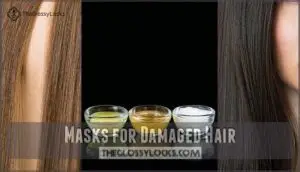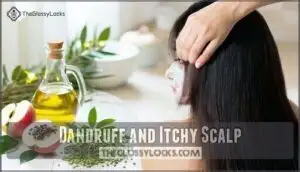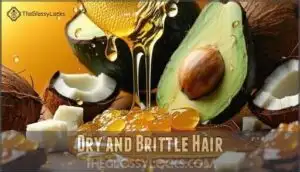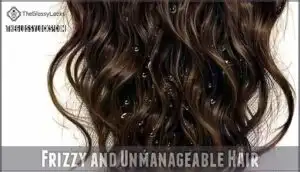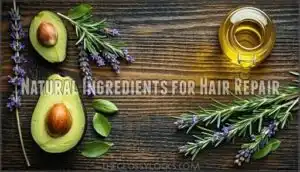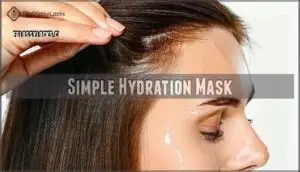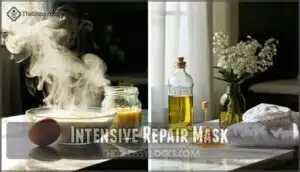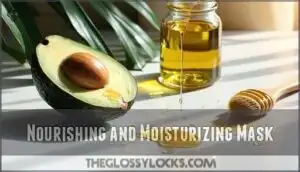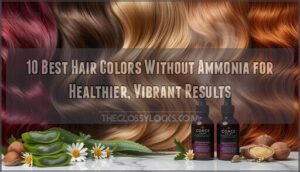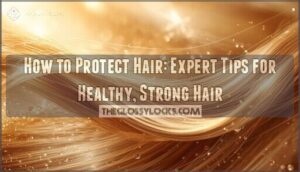This site is supported by our readers. We may earn a commission, at no cost to you, if you purchase through links.
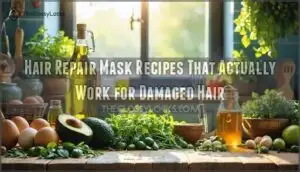 You can revive damaged hair with simple kitchen ingredients that pack serious repair power.
You can revive damaged hair with simple kitchen ingredients that pack serious repair power.
Try mixing mashed avocado with olive oil for deep moisture, or blend coconut oil and honey for strength-building proteins.
Egg and mayonnaise masks work wonders for brittle strands, while apple cider vinegar restores your hair’s natural pH balance.
These hair repair mask recipes use ingredients your grandmother probably swore by, and there’s real science behind why they work.
The key is matching the right ingredients to your specific hair damage – whether it’s dryness, breakage, or chemical processing aftermath.
Each recipe targets different hair concerns with precision to address issues like dryness.
Table Of Contents
- Key Takeaways
- Hair Repair Basics
- Masks for Damaged Hair
- Masks for Specific Hair Concerns
- Natural Ingredients for Hair Repair
- Homemade Hair Mask Recipes
- Frequently Asked Questions (FAQs)
- How to make a DIY hair mask for damaged hair?
- How do you make a DIY hair mask?
- What are the best DIY hair masks?
- Do DIY hair masks really work?
- What is a homemade hair mask?
- Can you make a hair mask at home?
- How do you make homemade hair breakage repair?
- What is the most effective homemade hair mask for dry hair?
- What is the best ingredient for extremely damaged hair?
- How often should I use hair masks?
- Conclusion
Key Takeaways
- Mix kitchen ingredients for real results – You’ll save money and control what goes on your hair by using items like avocado, coconut oil, honey, and eggs that actually repair damage at the molecular level.
- Match ingredients to your specific damage – You need protein-rich eggs for breakage, moisturizing oils for dryness, and apple cider vinegar for pH balance and buildup removal.
- Apply masks weekly for best results – You’ll see improvements by using these treatments once or twice per week, focusing on mid-lengths and ends where damage concentrates most.
- Target root causes, not just symptoms – You’re addressing underlying issues like cuticle damage, protein loss, and moisture imbalance rather than just temporarily masking problems with commercial products.
Hair Repair Basics
You’ve probably tried countless products promising to fix your damaged hair, only to end up disappointed and out of money.
Stop wasting money on products that don’t work—your kitchen has better solutions.
The good news is that your kitchen likely contains powerful ingredients that can actually repair and restore your hair’s health naturally.
Benefits of DIY Hair Masks
A mixing bowl and a few kitchen staples can be your secret weapon for hair repair.
DIY hair masks offer cost effectiveness, ingredient control, and endless customization options.
You’ll know exactly what’s going on your head, choosing natural alternatives and reducing environmental impact.
Homemade hair masks are a smart , safe damaged hair treatment, giving you a natural hair mask suited to your needs.
Common Hair Problems
You’re not alone if you’ve battled hair loss, oily roots, or product buildup.
Dull hair, split ends, and hair breakage can sneak up on anyone, especially after heat styling or coloring.
Damaged hair and dry hair often go hand-in-hand, making hair repair mask recipes feel like a lifeline when your strands need a serious rescue.
Key Ingredients for Hair Repair
If battling breakage, you need the right natural ingredients in your hair repair mask. Think of it as building a toolkit for your scalp health and hair repair journey.
Here’s what really works:
- Protein Power: Eggs and yogurt strengthen weak strands.
- Oil Benefits: Coconut and olive oil lock in moisture.
- Herbal Remedies: Aloe vera and apple cider vinegar clarify and soothe.
To further enhance hydration, consider using shea butter.
Masks for Damaged Hair
When your hair’s been through heat styling, chemical treatments, or environmental stress, it needs intensive repair to restore its strength and shine.
These three powerful mask recipes use scientifically-backed ingredients to penetrate damaged hair cuticles and rebuild your strands from the inside out, providing a form of intensive repair.
Avocado and Olive Oil Mask
Your hair’s worst days meet their match with an avocado and olive oil mask. Avocado benefits shine by sealing cuticles and adding moisture, while olive oil boosts shine.
For split ends, apply this DIY hair mask to damp hair, focusing on ends. Use weekly for best results.
Avocado oil can also promote healthy growth by nourishing the scalp and follicles. Here’s a quick look at why this hair repair mask works:
| Ingredient | Benefit | Mask Frequency |
|---|---|---|
| Avocado | Moisture, repair | Weekly |
| Olive Oil | Shine, nourishment | Weekly |
| Mask Application | Focus on split ends | Weekly |
| Avocado Hair Mask | Softens, smooths | Weekly |
| Olive Oil Mask | Strengthens strands | Weekly |
Coconut Oil and Honey Mask
Coconut oil penetrates your hair’s cortex, delivering deep moisture that honey helps seal in.
You’ll create this powerhouse combo by warming coconut oil slightly and mixing it with raw honey.
The coconut hydration works from within while honey’s humectant properties lock moisture at the surface.
Apply this mask application to damp strands, focusing on damaged areas for maximum scalp health benefits and repair.
Many users find coconut oil benefits hair.
Egg and Mayonnaise Mask
For those seeking powerful protein benefits, this egg hair mask delivers amino acids directly to damaged strands. You’ll create a nourishing treatment that targets hair breakage while supporting scalp health and promoting hair growth.
Here’s your egg hair mask application process:
- Mix the base: Combine 2 eggs with 3 tablespoons mayonnaise until smooth
- Add boosters: Blend in 1 tablespoon olive oil and 1 teaspoon honey
- Apply strategically: Work mixture from mid-shaft to ends, avoiding roots
- Time it right: Leave for 20-30 minutes under a shower cap
- Rinse carefully: Use cool water first, then shampoo to remove residue
This protein-packed combination repairs damage from the inside out. The eggs provide essential amino acids that rebuild weakened hair structure, while mayonnaise adds moisture and shine. Together, they create an effective hair damage repair treatment that strengthens strands and reduces future breakage.
Masks for Specific Hair Concerns
Different hair problems need different solutions, and the right mask can target your specific concern whether it’s stubborn dandruff, brittle strands, or unruly frizz.
These targeted treatments work by addressing the root cause of each issue with ingredients that have proven results for scalp health and hair repair.
Dandruff and Itchy Scalp
Flaky scalp got you scratching like crazy? This common issue affects nearly half of adults and stems from fungal overgrowth, particularly Malassezia yeast disrupting your scalp microbiome.
Combat dandruff treatment with tea tree oil masks—mix 5-10 drops into coconut oil for powerful antifungal action. Apple cider vinegar balances pH while reducing scalp inflammation naturally, making itchy scalp relief achievable through consistent application.
It could also be a sign of seborrheic dermatitis symptoms, which is related to seborrheic dermatitis and can be addressed with proper itchy scalp relief methods.
Dry and Brittle Hair
Brittle strands that snap at the slightest touch signal your hair’s cry for moisture.
Hair porosity determines how well your strands absorb hydration methods, while protein overload can worsen brittleness. Focus on scalp health and DIY hair mask treatments to restore flexibility.
Effective dry hair mask ingredients for hair breakage treatment:
- Coconut oil – penetrates hair shaft for deep conditioning
- Avocado – seals cuticles with natural fatty acids
- Honey – attracts moisture as a natural humectant
- Argan oil – repairs split ends with vitamin E
- Shea butter – creates protective barrier against further damage
Apply your moisturizing hair mask to damp hair, focusing on mid-lengths and ends where damage concentrates most.
Frizzy and Unmanageable Hair
When dealing with frizzy hair, humidity effects make your strands swell and separate at the cuticle level.
DIY hair mask recipes using argan oil and coconut oil penetrate different hair porosity levels for effective frizz reduction. These homemade hair mask solutions provide deep hair moisturizing without protein overload.
Banana masks, known for their silica and zinc, can also combat frizz and strengthen hair.
Apply before using gentle detangling methods and heat-free styling techniques for ideal hair repair solutions.
Natural Ingredients for Hair Repair
You’ll find that certain natural ingredients pack serious punch in the context of repairing damaged hair strands.
These powerhouse components work at the molecular level to restore strength, moisture, and shine to hair that’s been compromised by heat styling, chemical treatments, or environmental stressors.
Apple Cider Vinegar Benefits
Apple cider vinegar transforms your hair repair routine by restoring scalp pH to its natural 3.7-5.5 range.
This ACV rinse acts as a powerful hair clarifying agent, removing buildup while providing dandruff control through antimicrobial properties.
The acidity smooths cuticles, creating an instant shine booster that makes hair conditioning treatments more effective in your hair masks, which can be seen as a form of dandruff control.
Castor Oil for Hair Growth
Castor oil’s thick consistency delivers ricinoleic acid directly to your scalp, creating conditions that support healthy hair growth.
Castor oil feeds your scalp what it needs for stronger, healthier hair—right from the roots.
This powerhouse ingredient doesn’t magically sprout new strands overnight, but it works behind the scenes to optimize your scalp environment.
You can find various castor oil products online.
- Scalp Stimulation – Massage increases blood flow to follicles
- Hair Thickness – Deep conditioning reduces breakage appearance
- Oil Application – Weekly treatments seal moisture into strands
- Growth Cycle – Anti-inflammatory properties support follicle health
Rosemary and Essential Oils
While castor oil builds foundation strength, rosemary essential oil supercharges your hair repair mask recipes through proven scalp stimulation.
Clinical studies show rosemary benefits match minoxidil for hair growth activation. These essential oil blends boost circulation, delivering nutrients directly to follicles.
Rosemary’s antiseptic properties can also improve scalp health. Always dilute rosemary—3-5 drops per tablespoon carrier oil prevents irritation while maximizing oil application effectiveness for damaged strands.
Homemade Hair Mask Recipes
You don’t need expensive salon treatments when you can create effective hair repair masks at home using simple ingredients.
These three recipes target different levels of damage, from basic hydration to intensive restoration.
Simple Hydration Mask
When you need quick hydration for dry hair, this DIY hair mask delivers fast results.
Mix coconut oil and honey in equal parts for your homemade hair mask recipe. This mask application takes just 20 minutes on damp strands.
The ingredient alternatives include jojoba oil if coconut oil feels too heavy. For hydration frequency, use weekly.
Skip overnight hydration with this recipe—it’s designed for quick scalp hydration and immediate moisture restoration.
Intensive Repair Mask
When basic hydration isn’t enough, you’ll want this intensive repair mask for severely damaged hair.
This powerful treatment combines multiple hair repair techniques for maximum effectiveness.
- Protein Boost Recipe: Mix 2 eggs, 1 tablespoon mayonnaise, and 1 teaspoon olive oil for structural repair
- Deep Conditioning Treatment: Apply coconut oil and honey mixture, using heat application under a shower cap
- Overnight Masks Strategy: Leave argan oil blend on damaged sections for 8 hours for deep penetration
Use this mask frequency of once weekly for best hair repair solutions.
Nourishing and Moisturizing Mask
Think of your hair as a thirsty plant—give it a drink with this DIY hair mask.
Choose natural ingredients like avocado, honey, and olive oil for ideal hair nourishing and hydration levels.
For Mask Application, coat from roots to tips, try leave-in options for extra softness, and use gentle rinse techniques.
These hair mask recipes make hair hydration simple and effective. Many users find DIY masks beneficial for hair health and they can be used to achieve extra softness.
Frequently Asked Questions (FAQs)
How to make a DIY hair mask for damaged hair?
Like Phoenix rising from ashes, you’ll revive damaged strands with this repair blend.
Mix eggs, aloe vera, castor oil, lemon juice, and brown sugar.
Apply mid-shaft to ends, wait thirty minutes, then rinse thoroughly.
How do you make a DIY hair mask?
Mix ingredients like coconut oil, honey, and eggs based on your hair’s needs.
Apply the mixture to damp hair, focusing on damaged areas.
Leave for 15-30 minutes, then rinse thoroughly and shampoo.
What are the best DIY hair masks?
Taming unruly strands needn’t be overwhelming.
You’ll find coconut oil with honey deeply hydrates damaged hair, while avocado-olive oil masks seal split ends temporarily.
Rosemary-aloe blends boost growth through improved circulation, using natural ingredients to enhance hair health.
Do DIY hair masks really work?
Yes, DIY hair masks work by delivering targeted nutrients directly to your hair and scalp.
Natural ingredients like coconut oil, honey, and avocado contain proteins, vitamins, and moisturizing compounds that temporarily improve texture, shine, and manageability with consistent use.
What is a homemade hair mask?
A homemade hair mask is a DIY treatment you create using natural ingredients like oils, eggs, or honey.
You’ll apply it to your hair for deep conditioning, repair, and targeted benefits like moisture or growth stimulation.
Can you make a hair mask at home?
Creating hair masks at home is absolutely doable using everyday kitchen ingredients. You’ll find coconut oil, honey, eggs, and avocado work wonders for nourishing damaged strands and restoring shine naturally.
How do you make homemade hair breakage repair?
Mix coconut, argan, and almond oils for deep nourishment.
Apply to damaged areas, leave 20 minutes, then shampoo out.
These oils penetrate your hair shaft, reducing breakage while strengthening weakened strands effectively.
What is the most effective homemade hair mask for dry hair?
Coconut oil and honey create the most effective dry hair mask. Warm coconut oil slightly, mix with honey, apply to damp hair for twenty minutes, then rinse thoroughly before shampooing.
What is the best ingredient for extremely damaged hair?
Damaged hair loses up to 50% of its protein structure, making eggs your best repair ally.
You’ll find eggs pack amino acids and proteins that rebuild weakened strands from within, restoring strength.
How often should I use hair masks?
Use hair masks once or twice a week, depending on your hair’s needs.
If your strands feel parched or fried, weekly treatments help.
For healthy hair, biweekly is plenty—no need to drown your locks in goodness!
Conclusion
Like a gardener tending to wilted plants, you’ve now discovered the transformative power of kitchen-based hair repair mask recipes.
These natural treatments offer proven solutions for damaged strands without harsh chemicals or expensive salon visits. From avocado’s deep moisturizing properties to apple cider vinegar’s pH-balancing effects, each ingredient serves a specific purpose in restoring hair health.
Start with masks targeting your primary concerns—whether dryness, breakage, or chemical damage—and apply consistently for best results. Your hair’s recovery journey begins with simple, science-backed ingredients, and utilizing natural treatments can lead to significant improvements.
- https://www.inka.world/blogs/the-lunch-club/6-diy-hair-masks-that-really-work
- https://www.hairclub.com/blog/5-diy-natural-hair-masks-for-dry-damaged-and-thinning-hair/
- https://www.usatoday.com/story/life/health-wellness/2022/03/18/hair-masks-worth-hydration-repair-experts-share-advice/7060867001/
- https://thecalifornianaturals.com/products/deep-repair-hair-mask
- https://www.gminsights.com/industry-analysis/hair-mask-market

